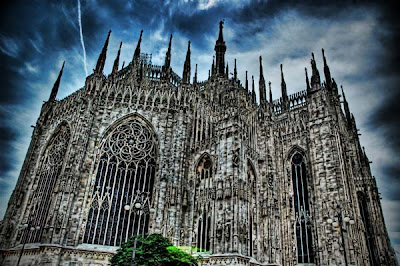I saw a post at America magazine's blog -
Avatar, the Mystical Gaze, and the Fate of Flesh. Here's the part I found especially interesting ....
[...] Avatar, uses the now common trope of the mind jacked into another world. Unlike Neuromancer or the Matrix trilogy, here the avitars are not virtual, but flesh. On this front Avatar is curiously ambiguous and perhaps undecided. On the one hand, there is the profound scene of Neytiri saving her lover Sully’s human body. Flesh touching flesh. Tears crossing the divide between worlds. But like the Matrix before it, in the end, the film opts against weak and paralyzed human flesh ......
Avatar ultimately chooses for the fantasy flesh of the Na’vi. Perhaps in the end, the film falls into a heresy Christians know all too well: that we and the world are beyond redemption. Sully’s broken, paraplegic body is left behind, gently dead among the roots of the Tree of Souls. His soul lives now as Na’vi to watch the humans perp walked out of paradise under heavily armed guard. Just as we can’t undo the flaming sword guarding paradise, so, in the end, we don’t seem to be able to imagine a redeemed human existence in our own. .... 
- paraplegic Jake Sully
I don't know if I understand this correctly, but what it says to me is that a person should try to find "redemption" in their disabled body rather than opting, if possible, for a different and healthy body. From what I've read it seems the Catholic view is that the soul is necessarily connected to a unique body. Call me a neo-Platonic/gnostic dualist, but I hate the idea that the "I" that is "me" is this particular body (this is a subject that always makes me upset - posted on almost the exact same thing
here :).
Here below are some bits on this subject from Keith Ward's book,
The Big Questions in Science and Religion, and also from one of his past Gresham College lectures,
Superhumans? - Interfering with nature.
First ......
**********************
The Big Questions in Science and Religion, (pp. 139-140)
The Christian idea of the soul was classically formulated by Thomas Aquinas, following Aristotle's
Peri Psyche, "On the Soul." The soul is defined as the "Form" of the body. Every physical object, in Aristotle's philosophy, has a Form or essential nature, that which makes it what it is. In organic beings, this Form is called a soul. So, plants and vegetables have souls. A potato, for instance, embodies the Form of "potatoness." The more like the Form of potatoness a potato is, the better it is as a potato. No material potato could ever be perfect, and all material potatoes embody their Forms to a greater of lesser extent. So, the Form is not a material thing. It is more like a conceptual entity, rather like a mathematical entity that can be expressed more-or-less well in many material instances .....
Aristotle differed from Plato in insisting that Forms must be expressed in matter. They do not have a completely independent and superior reality. Form is real, and matter is real, but Form and matter have to go together to compose a truly existent thing. It follows that the human soul does not truly or properly or "by nature" exist without a body. It gives to a piece of matter a distinctive set of intellectual capacities. That is its function --- the soul stands to the human body as potatoness stands to an individual potato .....
For Aquinas, a soul that exists without a body (like the souls in purgatory or heaven, for example) does so by a special act of God, and it does not really exist as a person in the full sense until it has a body in which to have experiences and act in an intersubjective world. Moreover, each soul is uniquely fitted to a specific body, and it cannot simply have a different body while remaining the soul of the same person. So, in the classical Christian view, it is important that in some sense, it is the same body that gets resurrected, however different its properties might be.
******************
And ....
*****************
Superhumans? - Interfering with nature[...] One traditional argument ... is that the physical bodies we actually have are an integral part of what we are, and they should not be treated as mere instruments, that we can change or discard just as we wish. God has created us as the body-soul unities that we are, and we are not morally free to change our bodies or our characters by artificial manipulation.
Such an objection is based on the view, which is certainly a traditional Christian one, that human bodies must be seen as parts of one integral and unitary personal reality, and are not disposable bits of mechanism. Despite some popular beliefs to the contrary, the traditional Catholic view of human persons is that they are physical bodies, animals, that possess emergent properties of consciousness and volition. To speak of a 'soul' is to speak of the capacities of a type of physical body, capacities of a type of animal capable of abstract thought and responsible action. Souls cannot properly exist without bodies - a view Aquinas espoused.
The complication here is that the soul is often also spoken of by Aquinas as though it is a non-physical agent of thought, action, sensation and perception. Some form of embodiment may be essential to it, in order to provide information, and the possibility of communication and action. But perhaps the same soul could be embodied in different forms ......
Catholics ... seem to be committed to the existence of souls, both in Purgatory and in Heaven, that have consciousness and experience, but do not have physical bodies. Moreover, whatever the resurrection body is, it is certainly not temporally or physically continuous with this physical body, and it may be significantly different in some respects (it will not be corruptible, and will not have exactly the same physical properties). Aquinas said that disembodied souls may exist 'improperly and unnaturally', by the grace of God, and will not fully be persons again until the resurrection. But it is obvious that a resurrected body will not be constituted of the same physical stuff as present bodies (it is said to be spiritual, not physical). The present physical universe will come to an end, and there will be 'a new heaven and earth'. What that means is that the physical stuff of this specific universe is not essential to the nature and continuous existence of persons, even though something analogous to this body must exist ......
What is at stake in this discussion is whether human consciousness is an emergent property of a physical object - and so ceases to function or exist without that object. Or whether human consciousness, though it does originate within a physical body, and does require some form of embodiment, is nevertheless dissociable from its original body, and is capable of existence in other forms. Is the soul adjectival to the body, or is this body just one form in which this soul may exist? Aquinas tries to straddle both sides of this divide by speaking of the soul as a 'subsistent form', something whose function it is to give a body specific capacities, but which is capable of existing, though not of functioning in its full and proper way, without that body .......
For Aquinas, the body is constitutive of what we are, and we would not be the same being without it, without the specific body we have. This is what is intended by the traditional Catholic view that each soul is fitted for a specific body. We might say that each soul is the unique soul of a unique body. From this two things have been said to follow. First, the finality of our bodily tendencies cannot be regarded as purely physical or pre-moral. Our bodily structure and inclinations are morally relevant, and relate directly to the fulfilment of the total human person, body and soul. Second, each person, as created in the image of God and ordered towards participation in the life of God, has intrinsic dignity and inviolability. It may therefore be thought that we are morally obliged not to perform any act that would change or modify our own unique body and character as it has been given to us in our creation. However, I do not think this follows .....
From a religious point of view, the goal of human life is not simply to survive or to reproduce. It is to know and love God for ever. The possession of some body is important to us, because we are embodied souls. But our bodies exist primarily to express the capacities of the soul .... the physical body does not have morally absolute status, and that the primary spiritual principle, besides the love of God, is the flourishing of personal life rather than the preservation of the present physical order, whatever it may be ....
*********************






























